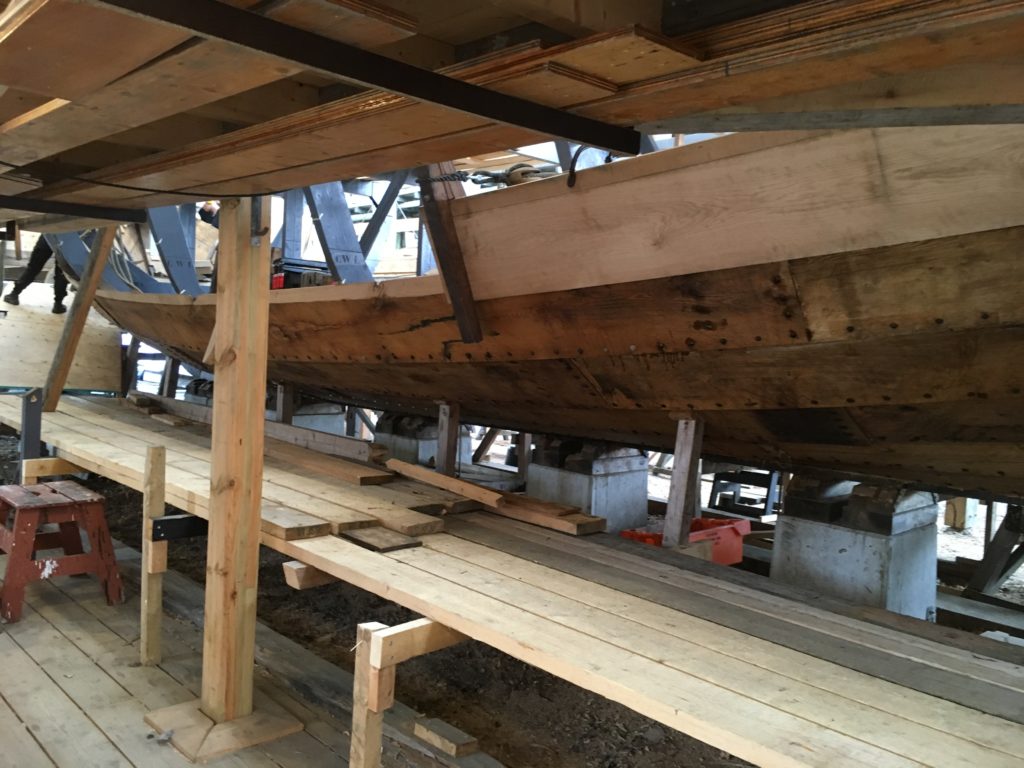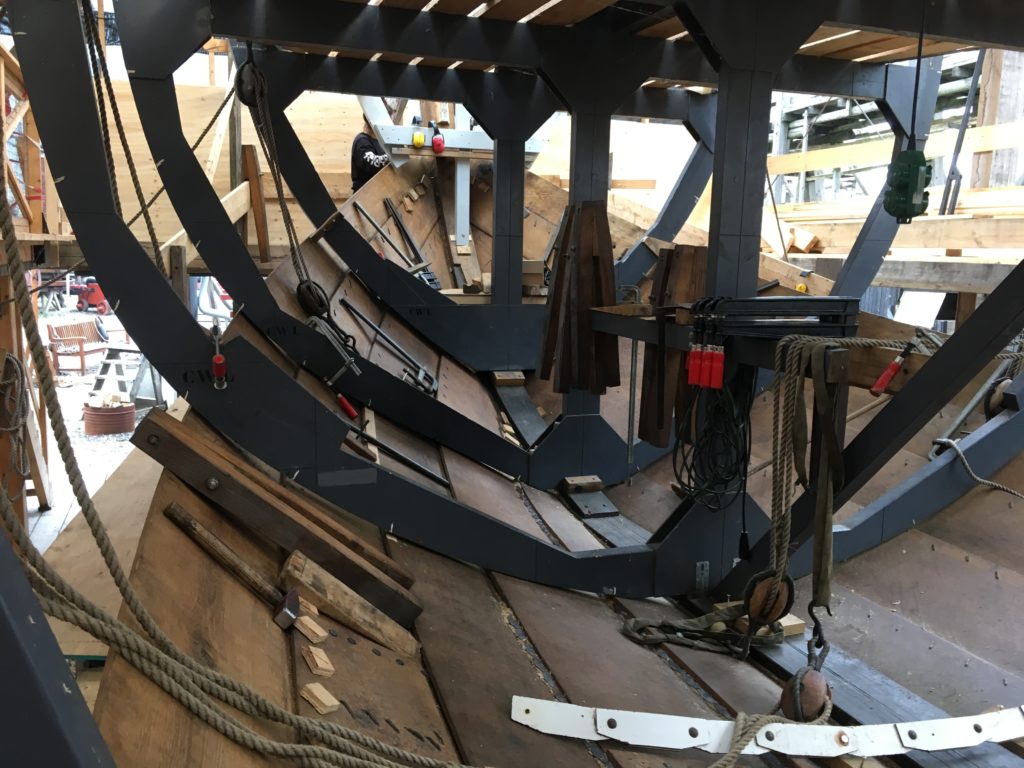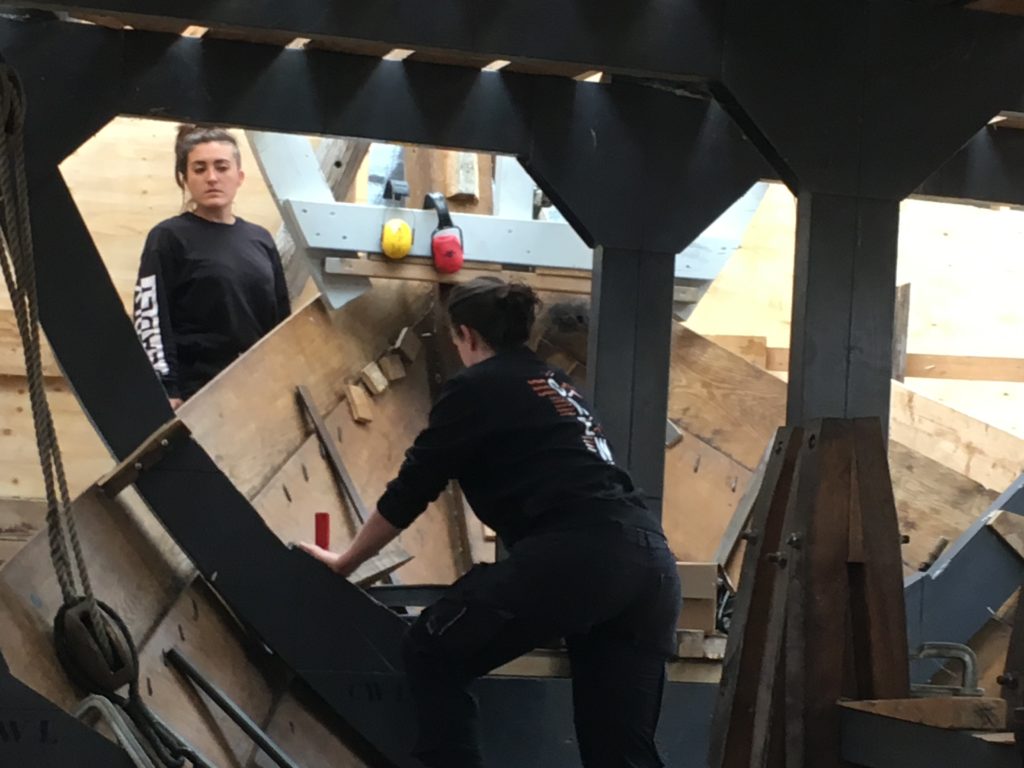A little distance eastwards, across the Zuiderzee from Amsterdam, Holland, is the town of Lelystad, where you’ll find Batavialand—a maritime museum. The main attraction of the museum is an impressive, full-scale reconstruction of a seventeenth century ship named the Batavia (hence the name of the museum).
The original Batavia was an East Indiaman, one of the ships built specially to sail to the East Indies, what we would refer to today as Southeast Asia: Sumatra, Malaysia, Borneo, and Indonesia, as well as the scattering of smaller islands all throughout that area. These were known as the Spice Islands, since they were the source of spices such as pepper, cloves, and nutmeg.
You can clamber aboard the replica of the Batavia and explore it, wandering from the Captain’s well-lit cabin aft to the somewhat claustrophobic gundecks amidships to the outdoor toilets at the bow. Very interesting.
The image at the top of this page depicts ships in the Amsterdam road (the “road” was the area of relatively deep water just outside a harbor where ships would “park”). The large ship on the right (bow to the viewer) and the ship in the middle (sailing away from the viewer, leftwards) are the same type of ship as the Batavia.
The Batavia isn’t the only attraction at Batavialand, though.
They are in the process of constructing another replica of a ship: a watership.
The image at the top of this page also depicts a watership. It’s the smaller vessel in the left foreground.
Waterships were around for a long time—from the late Middle Ages to the beginning of the nineteenth century. They were “workhorse” ships, solidly built vessels capable of performing a variety of tasks. There was one distinctive aspect to them, though, that distinguished them from other types of ships, and from which their name is likely derived,
Their holds were filled with water.
Not the entire hold, but a particular part of it known as the bun. This bun was designed as a place to keep live fish.
When waterships were in use, there were, of course, no refrigerators or freezers. But people were just as concerned back then with getting wholesome fresh fish as they are now. Waterships were the way to do that. They would sail out to meet the returning fishing fleets (which could not easily come in all the way to the docks), transfer the recently caught fish into their water-filled buns, and then transport the squirming, still-alive catch to the docks for immediate sale.
Waterships sometimes did the fishing, too, often using trawl nets. The image below (an enlarged section of the image at the top of this page) shows a watership unloading a fresh catch of fish into a smaller boat, to be rowed to the docks.
Waterships had a single mast equipped with what was known as a sprit, a small spar that rose diagonally from the mast to the upper outer corner of the sail. Sometimes, they had a square-rigged sail. They also had jib sails, triangular sails attached to the stays connecting the bow and the mast.
Traditionally, waterships had an area at the bow used for storage. Then came the bun amidships. The bun was partially decked over to form a workspace. Behind that was a further decked-over area that served as living quarters, where the crew cooked, ate, and slept. The image above doesn’t provide a clear depiction of any of this. You can see it all in the image below, though.
The replica of the watership that is under construction at Batavialand is a recreation of a medieval vessel. When completed, it will be 54 feet (16.5 meters) long and 16½ feet (5 meters) wide. It is clinker built, (this method of construction is also known as lapstrake). Viking longships are perhaps the most famous example of clinker-built ships—where the boards that form the hull of the ship overlap each other instead of fitting flush together.
The boards used for the hull and the decking of the recreated watership are of oak, a wood employed by shipbuilders for centuries. The mast is of pine. The ropes and sails will all be made in the Batavialand workshops out of hemp, another traditional material used for centuries. The ironwork on the watership (nails, fittings, etc.) will also all be made in the Batavialand workshops using traditional techniques.
The end result will be as close a replica of the original vessels as possible.
The construction is done by a varied team of local experts, student interns, refugees, and volunteers. Below is a series of photos depicting the vessel and the work being done on it.
The hull of the watership. As you can see, construction of the hull still has a ways to go.
The stern of the watership—pretty much complete.
View of the bow of the watership. You can clearly see the metal framework they use to form the shape of the vessel. Once the hull has been fully completed, the metal framework with be removed.
Interns working on the hull at the bow. You can clearly see how the boards of the hull overlap each other.
—§—
This blog, of course, is about Barbary corsairs. So what is the connection between Dutch waterships and Barbary corsairs?
Well…
The Dutch, as a major seafaring nation, had constant problems with Barbary corsairs, particularly in the seventeenth century. In trying to defuse the threat the Barbary corsairs offered, the Dutch resorted to a variety of responses, from outright warfare to diplomacy. At various times the diplomacy worked, and they were able to negotiate treaties with some of the corsair city states—Tripoli, Tunis, Algiers, Salé.
When these treaties were in effect (they didn’t always last very long), they granted Barbary corsair ships from particular cities the right to safely refit and revictual in Dutch ports, an opportunity quite a few Barbary corsair captains availed themselves of—to the fury of the French and the English, for often they didn’t have any such treaties and so were suffering attacks from the very ships that sailed casually, and safely, in and out of Dutch ports.
And the waterships?
Waterships were solid, versatile vessels that could be used for a variety of purposes. One of those purposes was to tow larger ships in and out of harbor.
So Barbary corsair ships that entered Dutch ports would likely have been towed in and out of harbor by waterships—just like other shipping.
It isn’t hard to imagine a gang of Barbary corsairs lounging around on the deck of their ship, making rude gestures at impotent French vessels unable to attack them, while a pair of waterships hauls them sedately into the harbor.
One of the many ironies of the seventeenth century.
For those of you who may be interested in Batavialand, here’s a link:
http://www.batavialand.nl/museum
 The Travels of Reverend Ólafur Egilsson
The Travels of Reverend Ólafur Egilsson
The story of the Barbary corsair raid on Iceland in 1627
Amazon listing





